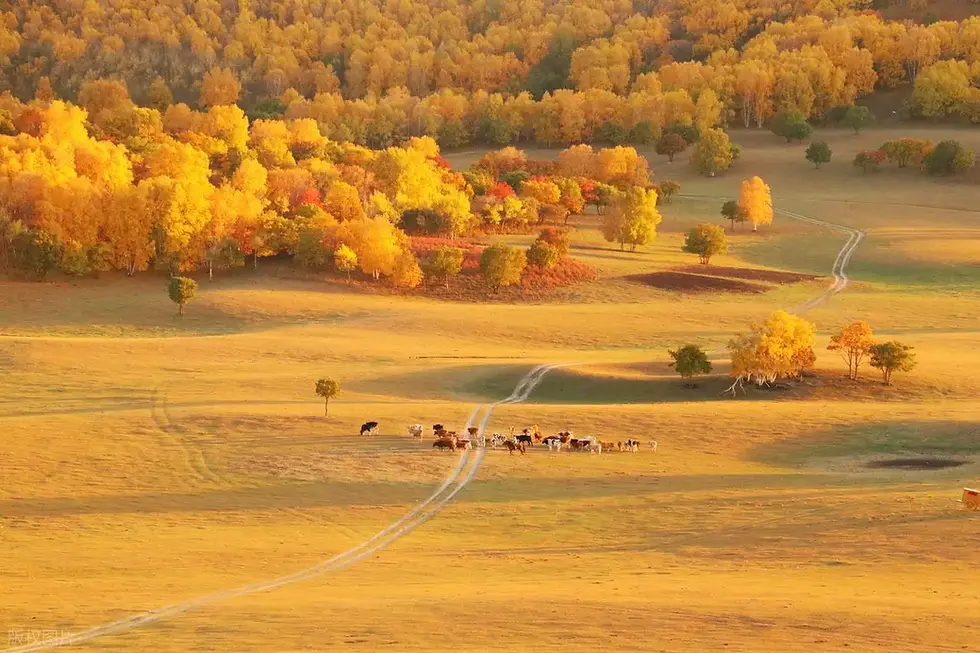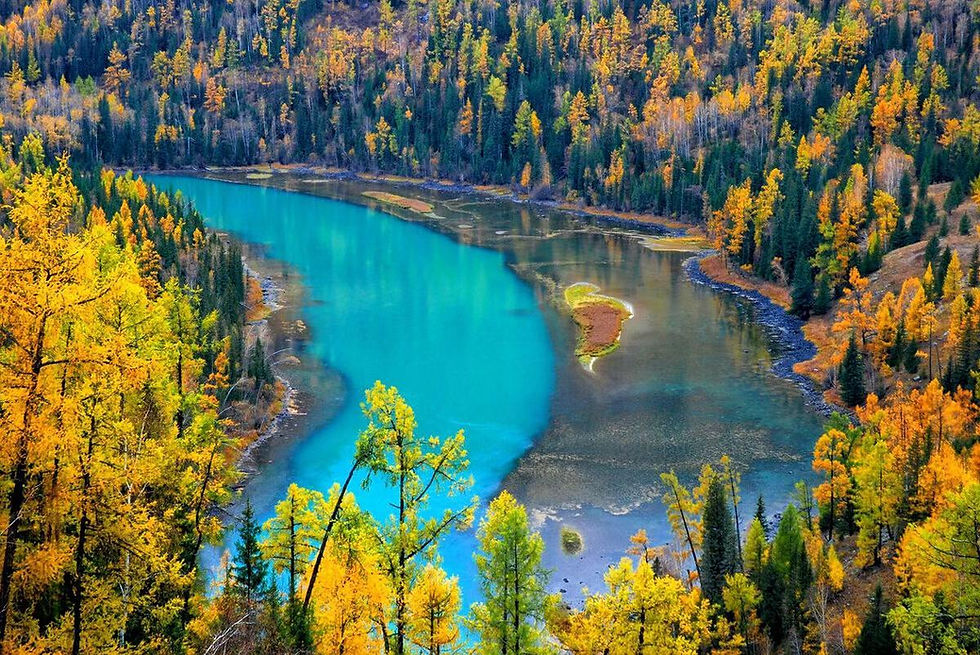Xinjiang Kanas: Golden Autumn Journey
- China Vistas

- 2 days ago
- 4 min read
Deep in the Altai Mountains of northern Xinjiang, there is a lake that legends call a “holy mirror of the heavens.” In autumn, this lake and its surrounding forests transform into a dreamland so colorful that locals like to say it looks as if the gods tipped over their paintbox. This is Kanas Lake, one of China’s most famous autumn destinations, where birch forests, snowcapped peaks, and turquoise waters come together in a dazzling seasonal symphony. For travelers, photographers, and seekers of beauty, autumn in Kanas is a once-in-a-lifetime pilgrimage.
A Feast of Colors – Nature’s Autumn Surprise
When autumn arrives, Kanas becomes a color festival. The birch forests turn golden, the larch trees blush orange, and the pines keep their deep green dignity. Against this backdrop, the lake’s water shifts shades throughout the day, from jade-green at dawn to sapphire-blue under midday skies. The contrast of snowy peaks, rolling meadows, and fiery forests creates an effect that many describe as a “visual explosion.”

It is no wonder that Kanas is often ranked among the most beautiful places in China for autumn photography. The reflections of gold and red leaves on the glassy water surface make every step along the shoreline feel like walking inside a painting.
Tuva Culture – The People of the Sacred Lake
Beyond the scenery, Kanas is also home to the Tuva people, a small ethnic group said to be descendants of ancient tribes related to Siberian and Mongolian nomads. They live in wooden houses, raise cattle and horses, and preserve their own unique traditions, music, and shamanistic rituals.

Walking into a Tuva village feels like stepping back in time. Smoke curls from log cabins, children chase horses across meadows, and elders play traditional instruments. The Tuva are also known for their throat singing and folk tales, many of which are linked to the sacred Kanas Lake.
One enduring legend says that the lake is guarded by mysterious water creatures, sometimes called the Kanas Lake Monster. Locals whisper about giant shapes rising from the deep, adding a mystical layer to the already enchanting landscape.
A Hidden Paradise for Hikers
For those who love hiking, Kanas is a paradise of secret trails and breathtaking views. Paths wind through birch groves, climb towards alpine meadows, and reveal panoramic views of valleys painted with autumn colors. Popular routes include the climb to Fish Watching Pavilion, where you can gaze down at the ever-changing hues of Kanas Lake, or the trek into Hemu Village, a settlement of Tuva wooden houses surrounded by morning mist.

Hiking in Kanas is more than exercise; it is a slow conversation with nature, each turn revealing a new surprise, whether it’s a golden hillside, a cluster of wild mushrooms, or a distant herd of horses grazing under snow-capped mountains.
Cultural Roots and Sacred Beliefs
Origins of the Tuva People
The Tuva culture is rich with nomadic traditions, blending Mongolian, Siberian, and Turkic influences. Their way of life—herding, hunting, and storytelling—has remained largely untouched by modern times, making them a living heritage in the region.
Grassland Stone Men and Rock Paintings
Scattered across the grasslands are ancient stone figures known as stone men, silent guardians left by past civilizations. Rock paintings found in valleys tell stories of ancestors, hunts, and rituals. These relics connect travelers to the deep historical layers of the Altai region.
Kanas Lake as a Holy Lake
For the Tuva, Kanas Lake is not just water but a sacred presence. Rituals, songs, and offerings to the lake reflect an ecological faith in living harmoniously with nature. This cultural depth makes a visit to Kanas not only beautiful but also spiritually enriching.

Practical Kanas Travel Guide
Transportation
By Air: The nearest airport is Altay Airport, with flights from Urumqi and other Xinjiang cities. Seasonal flights also connect major Chinese cities.
By Road: Long-distance buses or self-driving from Urumqi (about 10–12 hours) or Altay (3–4 hours). The scenic drive itself is worth the effort, passing deserts, grasslands, and snow peaks.
Accommodation
Inside Kanas Scenic Area: Options include guesthouses and boutique lodges in Tuva-style wooden cabins.
In Hemu Village: Traditional log houses offer cozy stays with local flavor.
In Burqin Town: A wider range of hotels from budget to mid-range, convenient as a base.
Clothing and Preparation
Layering is key: Autumn days are mild but mornings and evenings can be cold, especially near the lake.
Hiking gear: Comfortable shoes, rain jackets, and trekking poles for longer routes.
Photography essentials: Wide-angle and zoom lenses, extra batteries, and memory cards—because you will not want to stop taking pictures.
Tickets and Access
Kanas is a protected area, and entry tickets are required, usually including a shuttle bus pass. Prices vary by season, with discounts available for students and children. During the peak golden season, expect higher demand and plan early.
Beyond Kanas: Nearby Gems
Hemu Village: Misty mornings, Tuva log cabins, and some of the most iconic views in Xinjiang.
Baihaba Village: A borderland hamlet called “the last village of China,” surrounded by forests and snow peaks.
Burqin Town: Known for its colorful riverbanks, lively night markets, and delicious grilled fish.
The Gentle Goodbye
As autumn winds sweep across the Altai Mountains, the leaves of Kanas Poplar and birch forests drift down like golden snow. The turquoise lake grows still, and the villages prepare for winter. Yet for the traveler, the memory of Kanas lingers—of colors too bright to describe, of songs sung in wooden cabins, of trails that seemed to lead into dreams.

Visiting Kanas in autumn is not just about seeing a landscape. It is about walking inside a living painting, feeling both small and infinite under the mountains, and carrying away the quiet glow of a place where nature painted its masterpiece.
Contact us today to craft your dream China adventure!




Comments